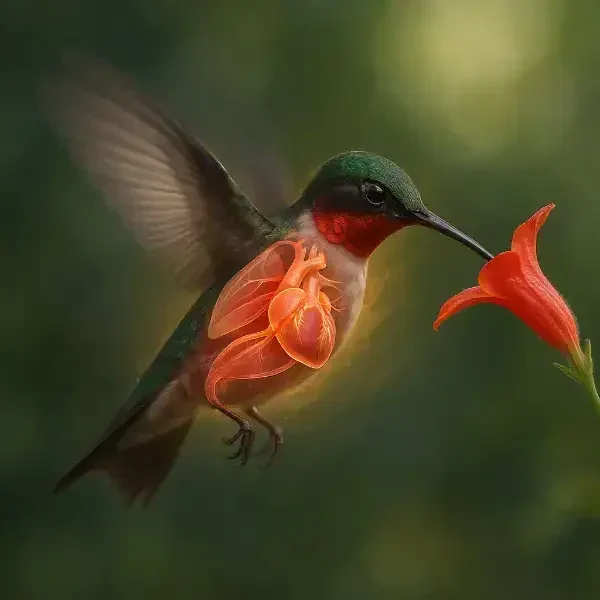(Or: How to Run a Power Plant Inside a Feather)
If the animal kingdom had an energy drink commercial, hummingbirds would be the undisputed stars. These tiny aerial acrobats don’t just push the boundaries of metabolism—they redraw them, tear up the rulebook, and then hover in place while doing so.
Let’s start with some numbers that make scientists double-take:
- Heart rate: Up to 1,260 beats per minute
- Wing beats: Up to 80 times per second
- Daily nectar consumption: Up to twice their body weight
- Energy burn rate: Highest of any vertebrate
The Daily Life of a Living Reactor
Imagine waking up essentially frozen, your body temperature dropped by a whopping 40°F, heart barely beating—welcome to a hummingbird’s morning. Within minutes, these remarkable creatures rev up their internal engine from near-death to full throttle, a feat that would make even the fastest sports car jealous. Their heart rockets from a torpid crawl to full speed, roughly twenty times faster than your heart rate while reading this article.
The Never-Ending Feast
Picture trying to eat twice your body weight in food every day while exercising continuously. Sounds impossible? Welcome to a hummingbird’s daily routine. These diminutive dynamos maintain a metabolic rate so high that they’re perpetually only hours away from starvation. If humans had the same metabolic rate, we’d need to consume around 300 hamburgers daily just to maintain weight. Your grocery bill would look more like a phone number, and drive-through workers would know you by name.
The daily energy demands require:
- Feeding every 10-15 minutes during active hours
- Visiting hundreds of flowers per day
- Processing nectar faster than it takes to read this sentence
- Converting sugar to energy at unprecedented rates
Sugar Rush Champions
While most creatures would spiral into a food coma after consuming their body weight in sugar, hummingbirds turn this seeming dietary disaster into an evolutionary advantage. Their bodies operate like microscopic sugar-processing plants, converting nectar to energy with an efficiency that would make industrial engineers weep with joy.
The Cardiac Miracle
At the heart of this metabolic marvel lies, well, a remarkable heart. Proportionally larger than other birds’ hearts, a hummingbird’s cardiac system performs at levels that should be physically impossible. It’s as if someone installed a jet engine in a matchbox and somehow made it work perfectly.
Key cardiac capabilities include:
- Pumping blood at rates that would explode lesser hearts
- Maintaining precise control despite extreme speeds
- Operating continuously at performance levels that would exhaust other species
- Adapting instantly to changing energy demands
Survival Mode: The Great Power-Down
Perhaps the most remarkable feat isn’t how hummingbirds maintain their high-energy lifestyle, but how they survive the night. As darkness falls, these living reactors perform an extraordinary shutdown sequence. They enter torpor, a state of controlled hypothermia that would send most creatures into emergency care.
During torpor, hummingbirds undergo dramatic changes:
- Body temperature drops by up to 40°F
- Heart rate slows by 95%
- Metabolism reduces to bare minimum
- Breathing rate becomes nearly imperceptible
Breaking the Laws of Energy Physics
Scientists are still scratching their heads over several aspects of hummingbird metabolism. How do they avoid diabetes despite consuming shocking amounts of sugar? Why don’t their organs overheat from constant operation at maximum capacity? It’s as if these birds received a special exemption from the usual rules of biology.
Conclusion: Nature’s Energy Miracle
Hummingbird metabolism isn’t just extraordinary—it’s a testament to nature’s ability to pack maximum performance into minimum space. These living proof that size doesn’t limit capability show us that sometimes the mightiest forces come in the tiniest packages.
Remember: The next time you feel tired after climbing a flight of stairs, somewhere there’s a hummingbird doing aerial acrobatics while processing nectar and probably judging your energy efficiency. They’re not just surviving; they’re thriving at the edge of what we thought was biologically possible.
And scientists are still debating whether these remarkable creatures are powered by actual biological processes or tiny nuclear reactors. The jury’s still out, but the smart money’s on “both.”


